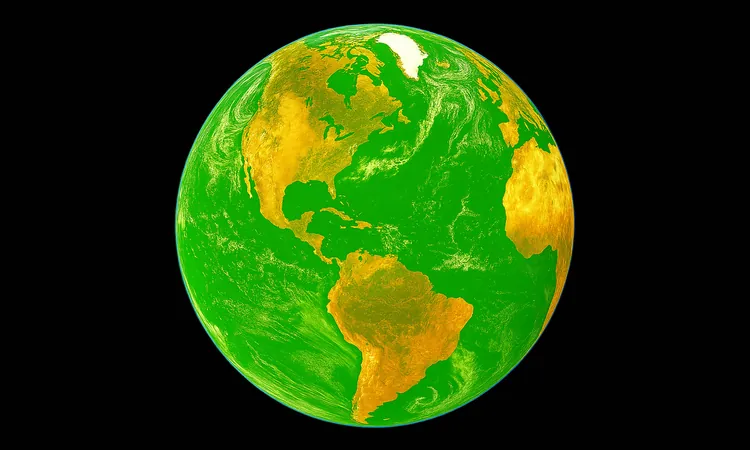
Earth's Secret Past: A Green Marble Before It Became Blue
2025-04-12
Author: Ming
Have you ever gazed at Earth from space and marveled at its mesmerizing blue hue? That iconic view might not tell the whole story. Recent scientific revelations suggest that around 2.5 to 4 billion years ago, our planet was enveloped in shimmering green oceans, radically different from the blue we see today.
A New Perspective on Earth's Early Oceans
In a groundbreaking study led by Taro Matsuo and his team at Nagoya University, published in Nature Ecology & Evolution, experts are reimagining the Earth’s early biosphere. They postulate that those verdant waters played an essential role in the evolution of cyanobacteria, one of life’s fundamental architects.
The Science Behind Earth’s Green Seas
Four and a half billion years ago, Earth took shape from cosmic debris, with life making its first appearance roughly 3.7 billion years ago. Before life emerged, the planet was largely covered in oceans, characterized by pronounced iron content.
With no oxygen present and an abundance of Fe(II), these ancient oceans lacked today’s blue clarity. Instead, sunlight interacted with iron-rich waters, bending more towards green hues.
Cyanobacteria: The Green Light Pioneers
The arrival of cyanobacteria was a game-changer, introducing oxygen that reacted with ferrous iron, producing rust-like particles. This transformation altered light penetration, making the oceans glow with emerald brilliance.
As Matsuo points out, this unique environment prompted cyanobacteria to adapt. To thrive, they developed phycobilisomes—complex structures that absorbed green light, which, under ordinary circumstances, was less effective for photosynthesis. This adaptation allowed them to flourish in the iron-rich waters.
Simulating the Past: Cutting-Edge Research
To validate their theory, Matsuo’s team conducted advanced numerical simulations, recreating the conditions of ancient oceans. Their findings showed that even with varying particle concentrations, green light persisted, favoring the survival of cyanobacteria equipped with PEB.
A Modern Echo of Ancient Oceans
In a quest to find real-world analogs, Matsuo explored Iwo Island, part of Japan's Satsunan archipelago. There, hydrothermal vents mimic the ancient processes, illuminating current waters with a green shimmer—exactly how it might have appeared billions of years ago.
Why It Matters: The Quest for Alien Life
The implications of this research extend far beyond Earth's history. Astronomers have typically searched for blue planets, assuming that it's the universal sign of water. However, Matsuo's findings suggest that iron-rich waters could appear much brighter and greener from afar, making it easier to spot extraterrestrial oceans rich in microbial activity.
A Transformational Journey of Discovery
The evolution of Earth's light environment has been pivotal, influencing life itself. After the Great Oxidation Event, as oxygen levels increased, our oceans cleared, and land plants began to flourish.
Matsuo’s initial skepticism evolved into conviction as the data unveiled a different portrait of early Earth—a pale green sphere where light sculpted life in ways previously unimagined. This comprehensive study enhances our understanding of not only Earth’s past but also guides how we search for life beyond our planet.



 Brasil (PT)
Brasil (PT)
 Canada (EN)
Canada (EN)
 Chile (ES)
Chile (ES)
 Česko (CS)
Česko (CS)
 대한민국 (KO)
대한민국 (KO)
 España (ES)
España (ES)
 France (FR)
France (FR)
 Hong Kong (EN)
Hong Kong (EN)
 Italia (IT)
Italia (IT)
 日本 (JA)
日本 (JA)
 Magyarország (HU)
Magyarország (HU)
 Norge (NO)
Norge (NO)
 Polska (PL)
Polska (PL)
 Schweiz (DE)
Schweiz (DE)
 Singapore (EN)
Singapore (EN)
 Sverige (SV)
Sverige (SV)
 Suomi (FI)
Suomi (FI)
 Türkiye (TR)
Türkiye (TR)
 الإمارات العربية المتحدة (AR)
الإمارات العربية المتحدة (AR)